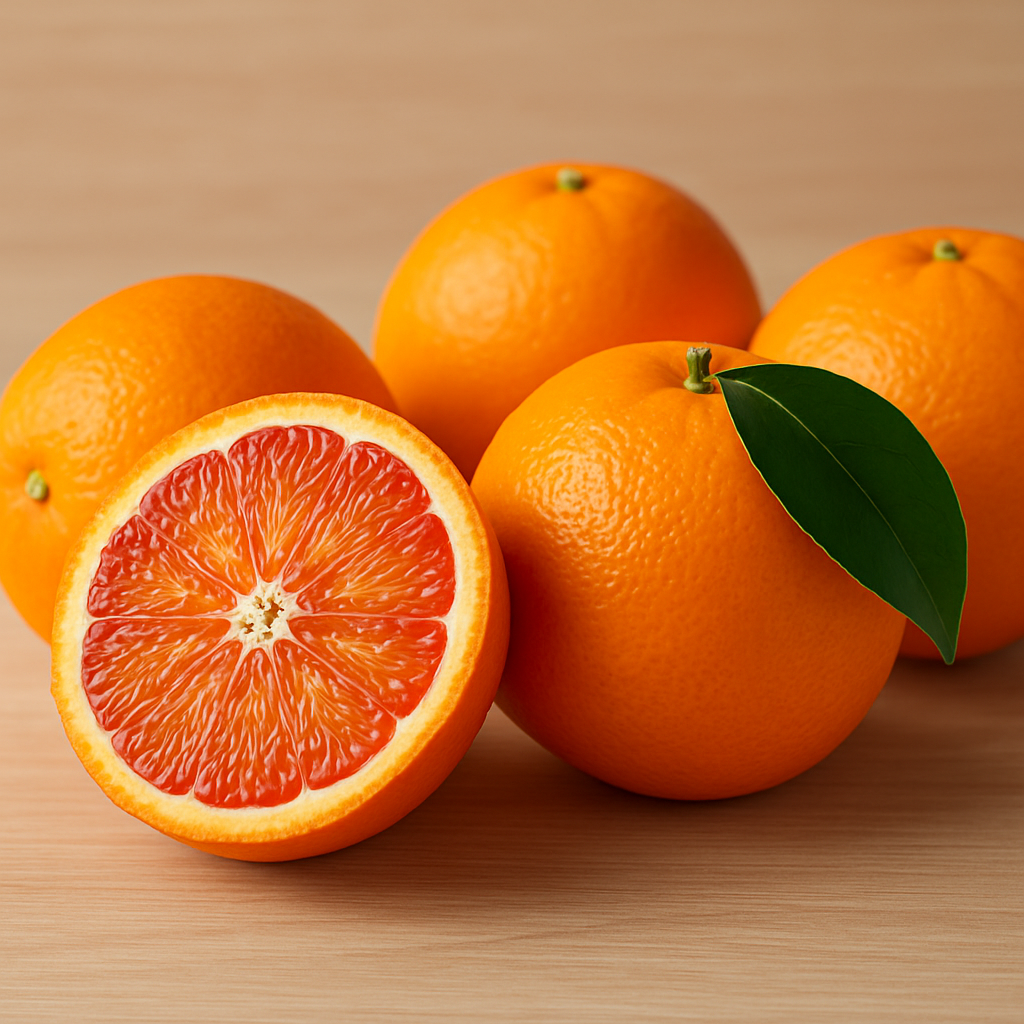Welcome to our special fruit and nutrition series, where we explore the world’s most beloved fruits—their history, nutritional benefits, health advantages, and culinary versatility. After reading, you’ll have the insight to choose the best fruits for your lifestyle.
Today’s spotlight is on one of nature’s brightest gifts: the orange.
Far more than just another fruit, oranges symbolize vitality, health, and natural sweetness. Their tangy-sweet flavor, vibrant color, and countless benefits have made them a global favorite for centuries. From royal palaces to everyday kitchens, the orange has shaped cuisines, health trends, and even culture itself.
In this comprehensive guide, we’ll dive into:
The fascinating origins of oranges
The different varieties and their flavors
The nutritional powerhouse inside every orange
Evidence-backed health benefits
Culinary versatility in sweet and savory dishes
Global cultivation & sustainability challenges
WHO guidelines on fruit intake
Common FAQs about oranges
Let’s peel back the layers of this citrus jewel.
The Origins of Oranges: A Journey Through Time
The story of oranges begins in the tropical regions of southern China and the Malay Archipelago, where citrus plants evolved over 8 million years ago.
Ancient Chinese literature mentions the sweet orange (Citrus × sinensis) as early as 314 BC. However, the orange’s worldwide journey truly began in the 9th century, when Arab traders introduced citrus fruits—such as bitter oranges, lemons, and limes—to the Iberian Peninsula.
By the 17th century, oranges were considered a luxury in Europe. Aristocrats cultivated them in lavish conservatories known as orangeries. King Louis XIV of France even built one of the grandest orangeries at the Palace of Versailles.
Fast forward to today oranges are grown across tropical and subtropical regions worldwide, making them one of the most consumed fruits on the planet.
Varieties of Oranges: A Spectrum of Flavors
Not all oranges are the same—different varieties bring unique flavors, textures, and uses.
Main Types of Sweet Oranges (Citrus × sinensis):
- Common Orange – Classic variety, widely juiced and eaten fresh.
- Blood Orange – Deep red flesh with a tangy, raspberry-like flavor.
- Navel Orange – Easy to peel, seedless, and perfect for snacking.
- Acidless Orange – Mild and sweet, ideal for those sensitive to acidity.
Other Popular Citrus Relatives:
- Mandarins – Smaller, sweeter, and easy to peel.
- Clementines – A seedless type of mandarin, kid-friendly and portable.
- Cara Cara Navel – A pink-fleshed orange with berry undertones.
- Seville Orange – Bitter and tart, famously used in marmalades.
- Tangerines – Bright, tangy, and aromatic.
Each variety has its place in cooking whether in juices, salads, desserts, or savory dishes.
Nutritional Benefits: A Powerhouse of Goodness
A medium-sized orange typically provides:
- Calories: ~58 kcal
- Vitamin C: ~70 mg (over 100% of daily needs)
- Fiber: ~3 g (supports digestion)
- Potassium: ~195 mg (heart health)
- Folate: ~53 mcg (cell growth & repair)
- Beta-Carotene: Precursor to Vitamin A (eye & immune health)
But here’s a surprise—orange peels are just as nutrient-rich! A 100 g peel contains:
- 45 mg Vitamin C
- 10.6 g Fiber
- Antioxidants like limonene, linked to anti-cancer properties
Though we don’t typically eat peels raw, they can be used in teas, marmalades, or candied snacks.
Health Benefits: More Than Just Vitamin C
Oranges are celebrated as an immunity booster, but their health advantages go far beyond that:
- Immune System Support – Vitamin C enhances white blood cell function.
- Skin Health – Promotes collagen production, aiding elasticity and wound healing.
- Digestive Health – Fiber improves gut microbiome and regularity.
- Heart Health – Potassium lowers blood pressure; fiber reduces cholesterol.
- Weight Management – Low calorie, water-rich, and filling—perfect for snacks.
- Antioxidant Protection – Flavonoids reduce inflammation and chronic disease risk.
WHO emphasizes that citrus fruits like oranges are essential in reducing risks of heart disease, stroke, and cancer.
Culinary Uses: From Breakfast to Gourmet
Few fruits are as versatile as the orange. Here’s how it shines in the kitchen:
- Juices & Smoothies – A breakfast classic.
- Salads – Adds brightness to green and fruit mixes.
- Desserts – Sorbets, cakes, puddings, and chocolate-orange pairings.
- Savory Dishes – Used in marinades, glazes, and sauces for poultry & seafood.
- Baking – Muffins, scones, and pastries infused with zest.
- Candied Peel & Tea Infusions – A fragrant, nutrient-rich twist.
Pro tip: Use orange zest in small amounts—it’s a secret weapon for depth of flavor.
Sustainability & Global Cultivation
Oranges are not just food—they are a global industry.
- 2022 production: ~76 million tonnes worldwide
- Top producers: Brazil (22%), India, China, Mexico
Millions of farmers depend on orange cultivation, but challenges exist:
- Climate change threatens yields
- Water scarcity affects irrigation
- Sustainable farming is crucial for future supply
Innovations like drought-resistant varieties and smarter irrigation are helping build a sustainable orange industry.
WHO Recommendations on Fruit Consumption
The World Health Organization (WHO) advises:
- Minimum 400 g of fruits & vegetables daily
- Variety is key—don’t rely on just one type
- Whole fruits > fruit juices (for fiber and reduced sugar intake)
Adding one or two oranges daily can make a big difference in achieving this goal.
FAQs About Oranges
Q1: Are oranges good for weight loss?
Yes—low calorie, high fiber, and hydrating, they keep you full.
Q2: Can I eat orange peels?
Yes, if washed thoroughly. Best used in teas, zest, or candied.
Q3: How should I store oranges?
At room temperature for a week, or refrigerated for up to 3 weeks.
Q4: Any side effects of eating too many?
Excess may cause acidity or enamel erosion. Moderation is key.
Q5: How do I choose the best oranges?
Look for fruits that are firm, heavy, and brightly colored.
Conclusion: Embracing the Orange
From its ancient Asian roots to its place in modern kitchens, the orange has proven itself as a symbol of vitality, taste, and health.
It’s not just a fruit it’s a global cultural icon, a nutritional powerhouse, and a versatile culinary ingredient. Whether eaten fresh, juiced, or zested into a dish, oranges brighten our diets and enrich our health.
So, next time you peel an orange, remember you’re enjoying a fruit that carries thousands of years of history and endless health benefits.
Embrace the orange, and let it fuel your health, energy, and zest for life.
Read our blog on Papaya Benefits: Nutrition, Uses & WHO Backed Health Guide https://newsarmour.com/papaya-health-benefits-nutrition-uses/
Sources –
https://www.who.int/tools/elena/interventions/fruit-vegetables-ncds
https://www.seedlipdrinks.com/en-aunz/journal/a-brief-history-of-the-orange
https://www.britannica.com/plant/orange-fruit






